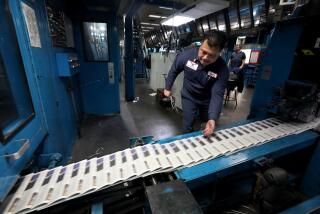The Morning Paper: A Love-Hate Affair : BEHIND THE TIMES, <i> By Edwin Diamond (Villard Books: $24; 394 pp.)</i>
People who love newspapers--the rough, real feel of them, the zaniness of them, the at times appalling thickheadedness of them--will like âBehind the Times.â Itâs an affectionate and also sometimes unfair, an endearing and also sometimes coruscatingly mean portrait of the modern New York Times--a daily print product that readers seem to care about far more passionately than any other 50-75 commodity they buy. In fact, for a good proportion of those readers--as for readers of Corriera della Serra or Le Monde or Yomiuri Shimbun or the Los Angeles Times, letâs say--the newspaper, as intimate and constant a part of daily life as breakfast, is held to a very special, very personal standard.
Yet it is precisely because that high standard is not always met that newspapers become, in effect, daily portraits of imperfection. For, as everyone in the business fully understands, if editors held back in order to attain what they judged to be the perfect newspaper before publishing, the next issue would never come out. And the whole point of newspapers, of course, is their appearance every single day.
New York resident Edwin Diamond, a regular contributor to New York Magazine and former senior editor at Newsweek, is one of those readers of the New York Times who does care passionately about his local newspaper and who indeed desires to hold it to the highest standard. Alas, it is his view that under todayâs management, the standards and taste of the New York Times are being eroded and that the paper is going off in the wrong direction.
As he puts it, at the end of the book, in his final word on Arthur Ochs Sulzberger Jr. (who formally succeeded his father as publisher of the New York Times in 1992): âUnfortunately, the high-profile objectives that (the new publisher) has pursued . . . seem limp banners for rallying the forces of sustained, serious journalism.â
Sulzberger Jr., in his opinion, may indeed have a brain the size of Times Square, but he has no compass, and thus wanderingly pursues âdowntown chicâ and âskin-deep diversityâ while imposing bizarre academic reforms on his besieged and bewildered business-side team.
Is Diamond right? The methodology of this provocative study is to examine not so much the content of the Timesâ reporting or the soundness of its editorial judgments as the logic of its internal editing processes and the personalities, proclivities, incivilities and indigestions of its star editors, foreign correspondents and reporters. Inevitably the resulting snapshot sometimes seems more like a Geraldo Rivera forced-entry videocam job at a state mental institution than a stately portrait of a major journalistic paradigm.
And it is precisely this methodology, perhaps even more than Diamondâs conclusions, that have made this book the target of considerable controversy and howling calumny back East--especially on West 43rd Street in Manhattan, the head bunker of the New York Times.
But the upside to this rather downbeat look at an institution that takes itself very seriously indeed is that âBehind the Timesâ is never dull reading. It never strays too far from the Big Question thatâs on the mind of every newspaper editor in America, which is: Since newspapers inevitably come in second to TV and radio in the timeliness department--indeed, even before the paperâs 5:45 a.m. thud on your front step, Ted Koppel may have already put the biggest story of the day into some perspective--what exactly do we need newspapers for?
Indeed, what for?
Thatâs the question Diamond feels is not being properly answered at the New York Times, and he organizes his book in part around the efforts of the paperâs editors to address it. The management of the New York Times, like management at papers elsewhere, is deeply aware that they may be the proprietors of a choo-choo train in the age of the jetliner. Younger people do not read much, or if they do, prefer not to read newspapers; and without new, younger readers coming on board, as the old ones die, so will the newspaper.
The New York Timesâ response, in part, has been to graft onto its institutional skin transplants from other, younger, hipper publications, whether Clay Felkerâs New York Magazine of the 1970s or the contemporarily trendy but now departed 7 Days, whose founding (and closing) editor landed at West 43rd Street as a much-touted editorial consultant. Diamondâs view is that all this âboutique-ification,â all the streaking after trendy, youthful, up-market readers, all the unseemly contorting of the classically operatic old Gray Lady into something more akin to a cabaret singer at a downstairs club smoker, inevitably comes at the expense of serious, traditional-values journalistic coverage. And that, asserts Diamond, is little short of a tragedy.
But in the absence of some kind of quantitative analysis, the assertion that serious coverage is the loser is unproven. It may, in fact, be incorrect. Moreover, Diamond gives little sign of understanding that the Big Question is just not an Easy Question. My God, itâs a frightening one.
Itâs also a question whose every conceivable answer is likely to upset some readers. For however much change may be needed at daily papers, all editors find that change--in its specifics--is the one thing readers donât want. Just as itâs the one thing most journalists (whose profession, after all, is to identify and explain change) cheerfully welcome and sometimes even demand just about everywhere else--but not at their newspapers.
A daily newspaper, it has been said, is like an old bathrobe, with its torn pockets, catsup stains and wandering belt strap. Now, should you surprise your mate by throwing that robe out and buying a new one, quite a shock may await you: Your better half may well evince unexpected affection and fierce longing for the more comfortable old rag of a robe.
Against this massive challenge, the editors of the New York Times (just like the rest of us mortals) will continue to stumble forward in an effort to revamp the bathrobe while its owner wears it. Diamond has very entertainingly, if often unflatteringly, chronicled the tumult, Angst, triumphs and tragedies of one major newspaper that, to its credit, is trying hard to adapt itself to changing times. And trying hard, while putting out a complex, difficult product--that study in imperfection called a newspaper. And doing that every day. No simple trick.
More to Read
Sign up for our Book Club newsletter
Get the latest news, events and more from the Los Angeles Times Book Club, and help us get L.A. reading and talking.
You may occasionally receive promotional content from the Los Angeles Times.






